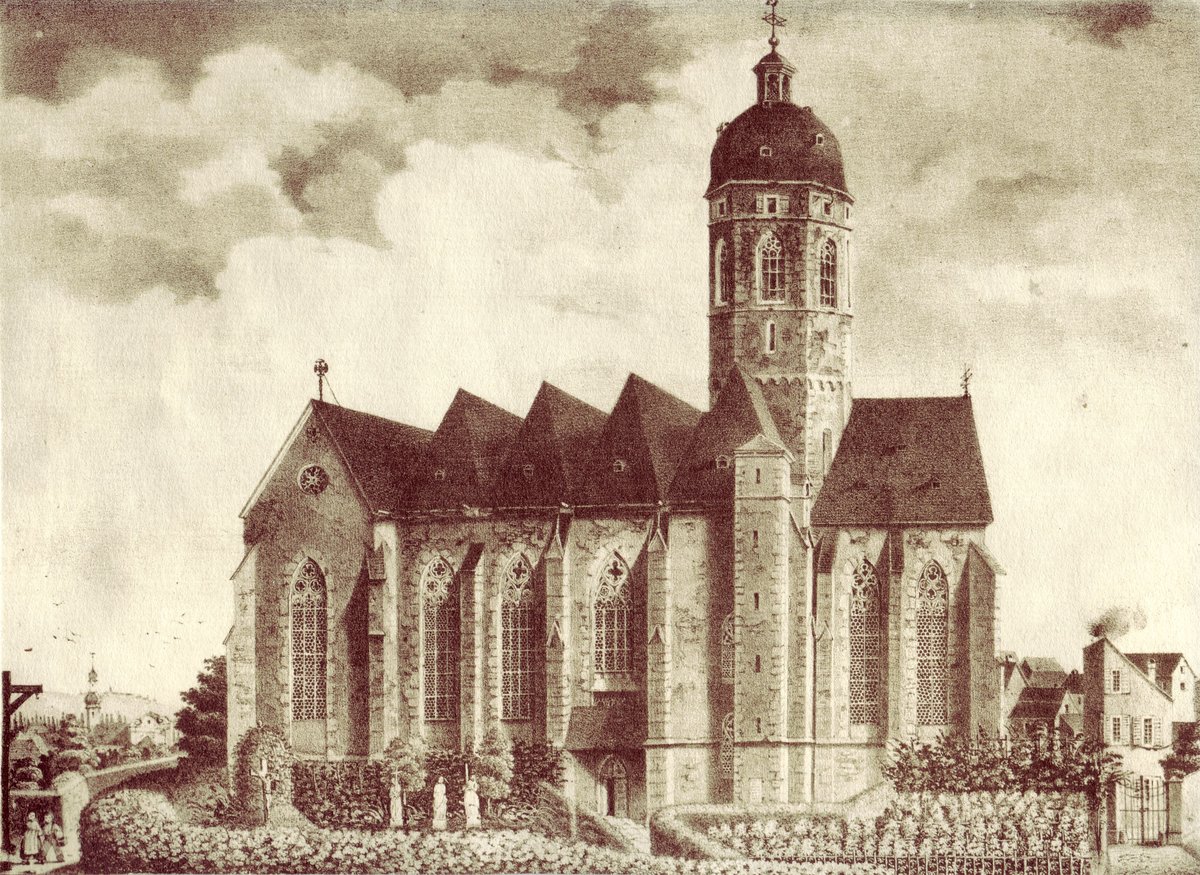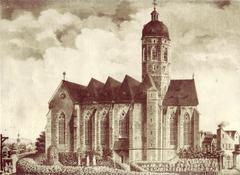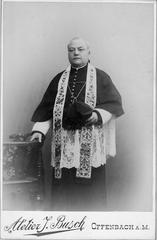
St. Stephen’s Church Mainz: Visiting Hours, Tickets, and Historical Significance
Date: 14/06/2025
Introduction
St. Stephen’s Church (St. Stephan) in Mainz, Germany, is an iconic destination that blends over a millennium of religious, cultural, and artistic heritage. Founded in the 10th century, this church stands as a testament to medieval architecture and spiritual tradition, but it is perhaps most renowned for its breathtaking stained glass windows by Marc Chagall. Today, St. Stephen’s not only draws pilgrims and art lovers but also serves as a symbol of interfaith reconciliation and hope (bistummainz.de; spottinghistory.com; mainz.de; itravelwithart.com).
This guide provides a comprehensive overview of St. Stephen’s Church Mainz, including its architectural evolution, the story behind the Chagall windows, practical visitor information, and tips for making the most of your visit.
Table of Contents
- Foundations and Early History
- Gothic Transformation and Artistic Heritage
- Damage, Restoration, and Modern History
- The Chagall Windows: Symbolism and Artistry
- Cloister and Medieval Treasures
- Liturgical and Community Life
- Visitor Information
- Location, Transport, and Nearby Attractions
- Events and Services
- Frequently Asked Questions (FAQ)
- Conclusion
- Sources
Foundations and Early History
St. Stephen’s Church was established around 990 AD by Archbishop Willigis, a leading ecclesiastical and political figure in the Holy Roman Empire. Conceived as the “Empire’s Place of Prayer,” the original Ottonian pre-Romanesque basilica reflected the growing influence of Mainz as a spiritual and imperial center (bistummainz.de; spottinghistory.com). Willigis’s burial at St. Stephen’s in 1011 further cemented its importance in medieval Germany.
Gothic Transformation and Artistic Heritage
By the 13th century, the original church had deteriorated, prompting a major Gothic reconstruction from 1257 to 1338. The resulting hall church, completed in 1340, is the oldest Gothic hall church in the Upper Rhine region (ourfrankfurtgermanymission.blog). Notable features include:
- Red sandstone construction
- Nave flanked by two aisles
- Dual choir arrangement (east and west)
- 66-meter-high tower, with a dome and lantern added in the 20th century
The church’s spacious and luminous interior, enhanced by expansive Gothic windows and ribbed vaults, was groundbreaking for its time (bistummainz.de).
Damage, Restoration, and Modern History
St. Stephen’s has survived multiple catastrophes:
- 1857: Explosion of a nearby powder tower destroyed the Baroque façade and caused significant damage (mainz.de).
- World War II: Allied bombing raids devastated the building, necessitating extensive postwar restorations. The Gothic vaulting was not rebuilt, honoring the complexity of its layered history (bistummainz.de).
These restorations returned the church to its Gothic roots, stripping away much of the Baroque embellishments and focusing on the medieval structure and furnishings.
The Chagall Windows: Symbolism and Artistry
Commission and Creation
Between 1978 and 1985, Marc Chagall, the Russian-French Jewish artist, designed nine stained glass windows for St. Stephen’s choir and transepts. This extraordinary collaboration—St. Stephen’s is the only church in Germany with Chagall’s windows—was commissioned as a gesture of reconciliation between Christians and Jews after the traumas of WWII (mainz.de; atlasobscura.com).
Chagall’s vibrant, predominantly blue windows flood the church with mystical light and depict biblical scenes, angels, and figures from both Jewish and Christian traditions. The windows illustrate themes of creation, salvation, and spiritual unity (itravelwithart.com).
Expansion by Charles Marq
After Chagall’s death in 1985, Charles Marq of the Atelier Jacques Simon in Reims, who had been Chagall’s collaborator for decades, created 19 additional windows for the side aisles, maintaining harmony with Chagall’s vision (bistummainz.de).
Cloister and Medieval Treasures
The late Gothic cloister (1462–1499) is one of the region’s most beautiful, featuring a net vault with pendant keystones. The cloister, a tranquil retreat from the city, was historically the burial ground for church canons and is adorned with coats of arms and tombstones (bistummainz.de; ourfrankfurtgermanymission.blog).
Other significant artworks include:
- 15th-century painting of God the Father
- Late Gothic sculpture of the Virgin and Child with Saint Ann
- Original Gothic baptismal font (1330)
- 13th-century altar table and late medieval tabernacle
Liturgical and Community Life
St. Stephen’s remains an active parish church, hosting regular Catholic services, weddings, baptisms, and community events. The church’s original baptismal font is still in use, and the sanctuary continues to be a center of spiritual life for Mainz (spottinghistory.com).
Visitor Information
Opening Hours
- March to October:
- Monday–Saturday: 10:00–18:00
- Sunday: 12:00–18:00
- November to February:
- Monday–Saturday: 10:00–16:30
- Sunday: 12:00–16:30
Note: The church may close during weddings, services, or special events; check the official parish website for up-to-date notices.
Admission and Tickets
Admission is free. Donations are appreciated to support preservation efforts. Some guided tours or digital guides may require a small fee (mainz-tourismus.com).
Accessibility
- Wheelchair accessible: Main entrance and nave are accessible; cloister and upper levels may have limited access.
- Restrooms: Not available in the church; public facilities are nearby.
- Gift Shop: Small kiosk offering postcards and literature.
Guided Tours
- Chagall Windows Tours: In-depth guided tours (in German and English) explore the windows’ biblical themes and Chagall’s life.
- Individuals can join scheduled tours; groups must book in advance via [email protected] or +49 6131 231640.
- Short Explanations: Brief (20–30 minute) talks after Sunday services.
- Cloister and Belfry Tours: Occasionally offered as part of special programs.
Visitor Etiquette
- Dress modestly.
- Maintain silence in the nave, especially near the Chagall windows.
- No food or drink allowed.
- Respect cordoned-off areas and ongoing services.
- Photography is allowed (no flash); check for restrictions during services.
Location, Transport, and Nearby Attractions
- Address: Stephansberg 2, 55116 Mainz, Germany
- Transport: Easily accessible via public transport (tram stop “Schillerplatz”) and a short walk from Mainz Hauptbahnhof. Limited parking nearby; public transport is recommended.
- Nearby Attractions: Mainz Cathedral, Gutenberg Museum, the Old Town, cafés, and restaurants are within walking distance.
Events and Services
St. Stephen’s Church hosts regular Mass, concerts, and cultural events, especially in the summer. Sightseeing is not permitted during religious services. For current schedules, visit the parish calendar.
Frequently Asked Questions (FAQ)
Q: What are the opening hours of St. Stephen’s Church Mainz?
A: March–October: Mon–Sat 10:00–18:00, Sun 12:00–18:00; November–February: Mon–Sat 10:00–16:30, Sun 12:00–16:30.
Q: Is there an entrance fee?
A: No, entry is free; donations are welcome.
Q: Are guided tours available?
A: Yes, guided tours (including the Chagall windows and cloister) are available in German and English. Book in advance for groups.
Q: Is the church accessible for wheelchairs?
A: The nave and main entrance are accessible; some areas may have limited access.
Q: Can I take photos inside?
A: Yes, non-flash photography is generally permitted.
Conclusion
St. Stephen’s Church Mainz is a living monument to faith, art, and reconciliation. Its centuries-old architecture and world-famous Chagall windows create a unique space where history, spirituality, and artistry converge. Whether you seek the serenity of its cloisters, inspiration from its stained glass, or an encounter with Mainz’s living history, St. Stephen’s offers an unforgettable experience.
For the latest information, guided audio tours, and travel tips, download the Audiala app and follow us on social media. Discover more about Mainz’s historical sites and plan your visit to this extraordinary church today.
Sources
- bistummainz.de
- spottinghistory.com
- ourfrankfurtgermanymission.blog
- mainz-tourismus.com
- mainz.de
- itravelwithart.com
- atlasobscura.com




































































































































